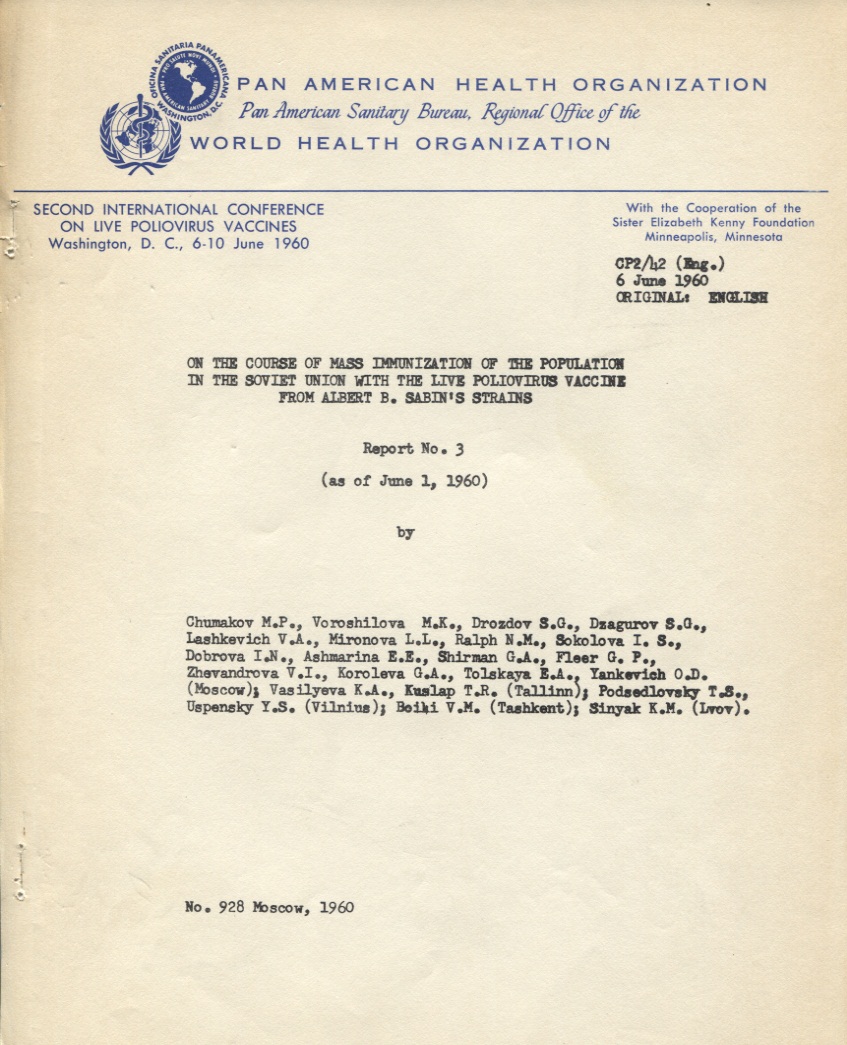
Attendees of the Second International Conference on Live Poliovirus Vaccines pose for a group photograph.
Another photograph from our collection can be seen here. It was taken during the Second International Conference on Live (Attenuated) Poliovirus Vaccines, which was held in June 1960 at Georgetown University in Washington D.C. and sponsored by the Pan American Health Organization, the World Health Organization, and the Sister Elizabeth Kenny Foundation. According to the back of the photo, participants came together “to discuss [the live polio vaccine’s] present status, trends and possibilities for use of this type of vaccine to delineate guidelines for conduct of further work and field programs.” Dr. Sabin was in attendance. Can you spot him in the crowd?

Dr. Chumakov's report on mass immunization in the Soviet Union, which he presented at the Second International Conference on Live Poliovirus Vaccines in 1960.
We have a couple of folders in our collection that are related to this meeting, which contain reports from the different presenters. One of the reports that I found was from Dr. Mikhail P. Chumakov, the Director for the Institute of Poliomyelitis Research, and his colleagues in the Soviet Union, who used Dr. Sabin’s vaccine strains during the mass immunization of the Soviet Union. In his report, Dr. Chumakov stated that the “immunologic activity of Sabin’s attenuated strains compared quite favorably with best standards of killed Salk vaccine and was even superior to them with regard to the time of seroconversion and its duration.” He also reported that over 90% of the Moscow population under the age of 20 was vaccinated, which lead to a “sharp reduction in poliomyelitis incidence.” Finally, Dr. Chumakov highlighted the “fruitful international cooperation” among the United States, the Soviet Union, and other countries. He hoped that the success of this cooperative effort to eradicate polio would help scientists all over the world to work together to defeat other diseases.[1]
Other scientists presented their findings on oral vaccine trials in Israel, Japan, South Africa, and the Belgian Congo. Although not all reports used the Sabin strains, men such as Dr. H. Pette from Germany and Dr. Manuel Ramos Alvarez from Mexico contributed reports on the strains.
The report from Dr. Chumakov was the most interesting to me because of his relationship with Dr. Sabin, as historian David M. Oshinsky referred to as “a bond […] that matured into a lifelong friendship (an odd one, given that Chumakov never learned English and Sabin barely spoke Russian).”[2] That in itself is interesting, but the fact that Chumakov’s vaccine trials in the Soviet Union helped introduce the Sabin vaccine in the United States, make their relationship even more fascinating. In a future blog, I want to explore this relationship further.
[1] “On the course of mass immunization of the population in the Soviet Union with the live poliovirus vaccine from Albert B. Sabin’s Strains” by M.P. Chumakov, et. al. can be found in Series #7 Oral Polio Vaccine; Box #20, WHO; File 4, 1960 — 2nd International Conference on Live Poliovirus Vaccines, Reports, June 6.
[2] David M. Oshinsky, Polio: An American Story, New York: Oxford University Press (2005): 252.
In 2010, the University of Cincinnati Libraries received a $314,258 grant from the National Endowment for the Humanities (NEH) to digitize the correspondence and photographs of Dr. Albert B. Sabin. This digitization project has been designated a NEH “We the People” project, an initiative to encourage and strengthen the teaching, study, and understanding of American history and culture through the support of projects that explore significant events and themes in our nation’s history and culture and that advance knowledge of the principles that define America. Any views, findings, conclusions, or recommendations expressed in this blog do not necessarily reflect those of the National Endowment for the Humanities.
